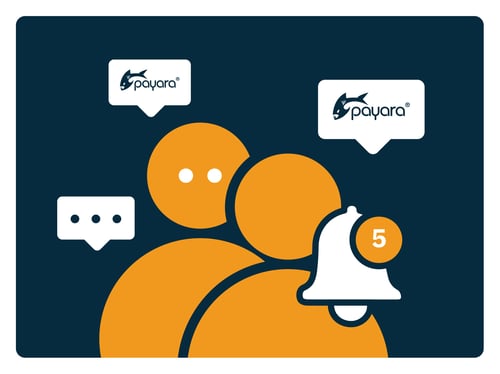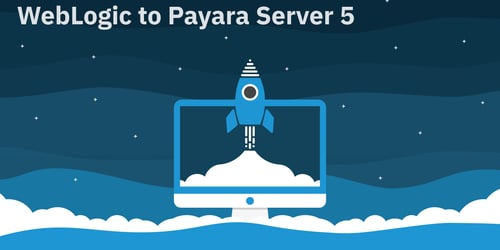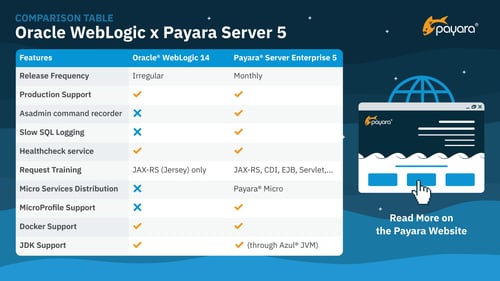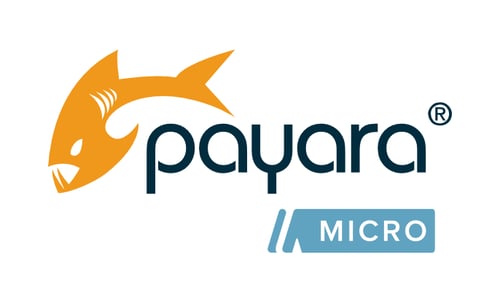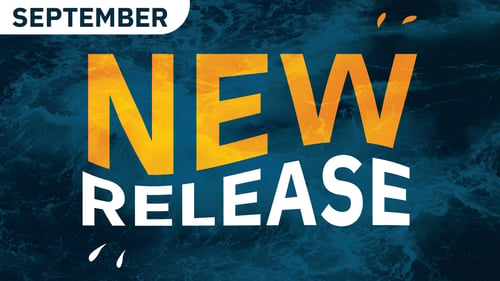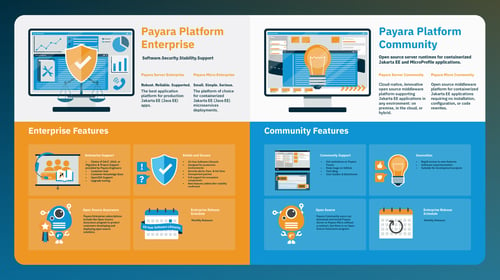Notifier API Updated for Payara Server Community Edition
Published on 20 Oct 2020
by Debbie Hoffman
Topics:
JakartaEE,
New Releases,
Extensions,
Notifier
|
0 Comments
Previously, Payara Server did not offer a convenient way to add extensions. If you wanted to add an extension, you had to download the Payara Server code base, build the entire repository, write your own extension and module, and basically act as a developer. We’re working to create a simplified way to add extensions to Payara Server, starting with the Notifier API.
WebLogic to to Payara Server Enterprise Migration Resources
Published on 09 Oct 2020
by Debbie Hoffman
Topics:
JakartaEE,
Migration,
WebLogic
|
0 Comments
Benefits of Migrating from Oracle WebLogic 14 to Payara Server Enterprise
Published on 01 Oct 2020
by Debbie Hoffman
Topics:
Migration,
WebLogic
|
0 Comments
Payara Server Enterprise 5 is a cloud-native middleware application platform supporting mission critical production systems with reliable and secure deployments of Jakarta EE (Java EE) applications on premise, in the cloud, or hybrid environments. If you’ve been running WebLogic in production but are struggling with an infrequent release schedule, bug fixes, and patches - or if you want support for Eclipse MicroProfile, you’ll benefit from migrating from WebLogic to Payara Server Enterprise.
Benefits of Using Payara Micro in the Cloud
Published on 17 Sep 2020
by Debbie Hoffman
Topics:
Payara Micro,
Cloud
|
0 Comments
Microservices architecture allows developers to apply best practices for larger systems learned over time with containerized Jakarta EE (Java EE) application deployments in any environment: on premise, in the cloud, or hybrid. Using Payara Micro in the cloud offers benefits ranging from reduced expenses, seamless integration with cloud platforms and tools for management and automation, to automatic and elastic clustering.
What's New in the Payara Enterprise Platform September Release?
Published on 14 Sep 2020
by Debbie Hoffman
Topics:
JakartaEE,
New Releases,
Payara Enterprise
|
0 Comments
We're happy to announce that Payara Platform Enterprise 5.21.2 (request here) Edition is out today!
GlassFish to Payara Server Migration Resources
Published on 08 Sep 2020
by Debbie Hoffman
Topics:
GlassFish Migration
|
0 Comments
Payara Server was created in 2014 as a fully-supported drop-in replacement for GlassFish. As Payara Server developed, its popularity has grown quickly among the community due to an open and responsive development team, a regular release cycle, and the introduction of crucial production enhancements that were never available in GlassFish. Migrating from GlassFish to Payara Server can be simple and straightforward - and we make it even easier with migration guides and a growing library of migration resources.
Benefits of Migrating from GlassFish to Payara Server Enterprise 5
Published on 07 Aug 2020
by Debbie Hoffman
Topics:
GlassFish Migration
|
0 Comments
Payara Server Enterprise 5 is a cloud-native middleware application platform supporting mission critical production systems with reliable and secure deployments of Jakarta EE (Java EE) applications on premise, in the cloud, or hybrid environments. If you’ve been running GlassFish in production but are struggling with a lack of support and infrequent application server releases, bug fixes, and patches - or you want to run on JDK 11, you’ll benefit from migrating from GlassFish to Payara Server.
Protecting Critical Ecommerce Infrastructure During Times of Crisis
Published on 28 Jul 2020
by Debbie Hoffman
Topics:
Payara Enterprise
|
0 Comments
With an estimated third of the global population under “lockdown” during the peak of COVID-19, organizations were forced to rapidly shift to remote working environments - prepared or not. The unplanned change in operations put significant pressures on existing systems and tested business continuity plans.Check out this whitepaper with the results of a recent survey of the community to learn about COVID-19 business challenges and how open source technology has helped.
Changes to Payara Platform Community Versioning System
Published on 17 Jun 2020
by Debbie Hoffman
Topics:
Payara Server 5,
JakartaEE
|
0 Comments
As the recent June release (download here!) marks the first official release since splitting our product into two separate software editions, Payara Platform Enterprise and Payara Platform Community, you may notice the versioning has been updated.
Payara Platform Release Stream and Software Changes
Published on 08 Jun 2020
by Debbie Hoffman
Topics:
JakartaEE,
Payara Platform,
Payara Enterprise
|
0 Comments

